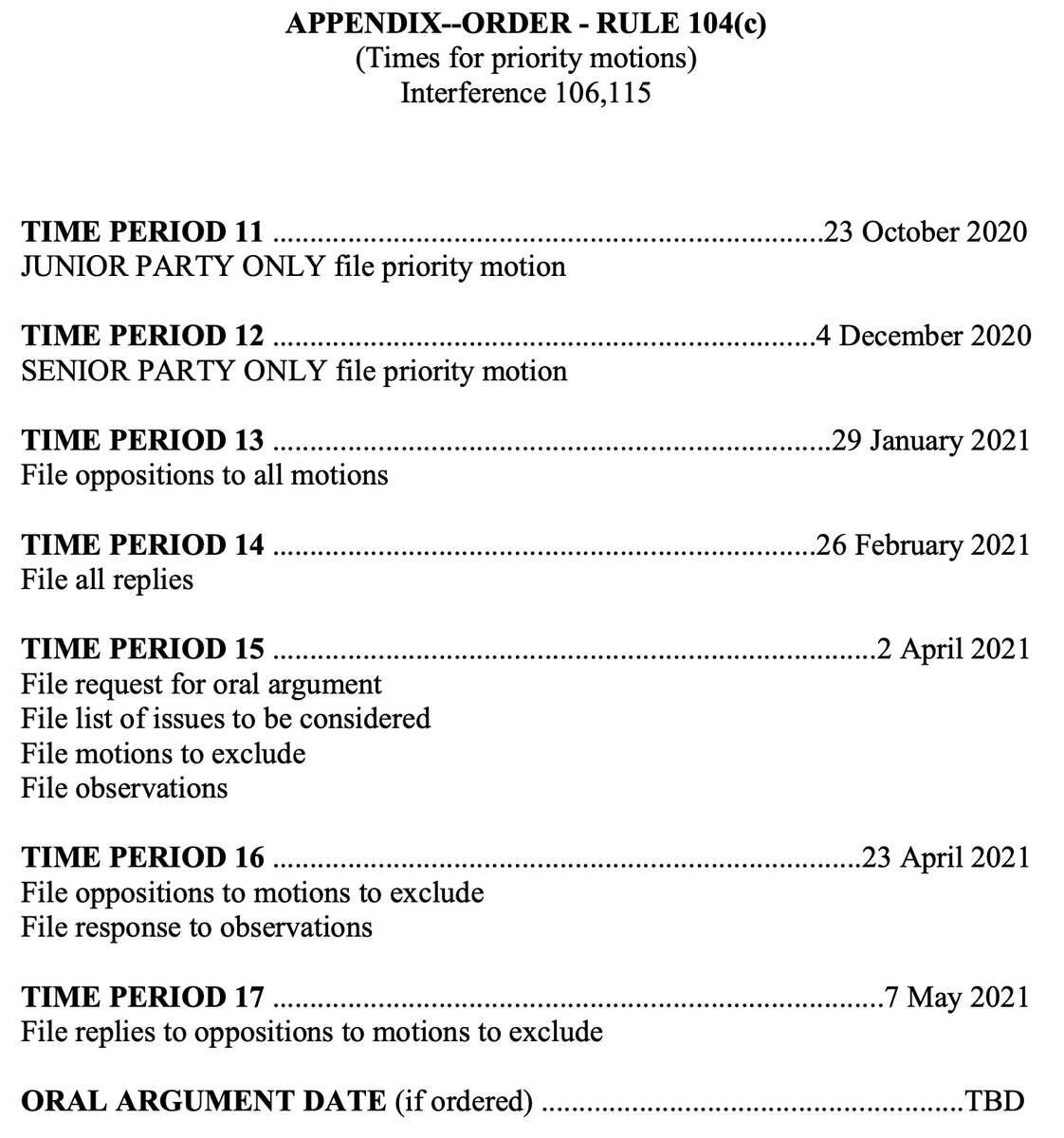
Alright, every, time to take a break from our dystopian hellscape and get back to some fun stuff—the *just out* #CRISPR #patent interference decision. What does it mean? What happened? What happens next?
This is a Tweetstorm. Come along and ride with me: /1
This is a Tweetstorm. Come along and ride with me: /1
https://twitter.com/jsherkow/status/1304424902771040256
First, a bit of history. As you may remember, we've been here before. Broad & UC had a previous interference that focused on CRISPR-Cas9 *eukaryotic* claims back in 2016/2017, affirmed by the CAFC in 2018. /2
In *that* interference, the PTAB declared there was no interference-in-fact between the parties' sets of claims. UC consequently went back to the PTO and, in a surprising decision, got some of its general (i.e., pro- and eukaryotic) system claims granted. /2
The PTAB must have been none-too-fond of this move, because it then *sua sponte* declared a *second interference* between UC's newly issued claims and Broad's old claims.
*Narrator*: This was unusual.
/3
*Narrator*: This was unusual.
/3
Generally speaking—and over-simplifying—you can't have 2 interferences on the same subject matter post an NIF finding and so a major issue in *this* interference (let's call it the Second Interference) was what the basis of the interference was going to be, i.e., the "count." /4
From the lawyer's perspective, there's *a lot* of strategy involved in making this determination. You can argue the count, but then you'll need to make sure you have the evidence in hand to show you have the earlier invention date. It's tricky. /5
After the declaration of the Second Interference, the parties—like they did last time—filed a flurry of motions, jockeying for position on the count, their proofs (i.e., evidence used to get earlier priority dates), priority dates, and what happened in the First Interference. /6
In particular, the major motions were Broad's estoppel motion—that the First Interference decided everything and we shouldn't be here; Broad's motion to remove some of its claims from the Second Interference; Broad's motion for an alternative count... /7
And Broad's motion for a benefit of its earliest priority date, Dec. 12, 2012.
On UC's side these included a motion for a priority date as early as May 25, 2012; and an alternative motion on priority date if Broad won on changing the count. /8
On UC's side these included a motion for a priority date as early as May 25, 2012; and an alternative motion on priority date if Broad won on changing the count. /8
The PTAB held oral arguments on these motions for this first ("interlocutory phase") back on May 18, 2020—by teleconference, because, you know, #pandemic. And we've been waiting for a decision—until today. /9
The decision that came out today—link in the top Tweet to this thread—resolves all these motions. And it does in a way that, I suspect, will *greatly* favor #Broad. Barring a last minute gem found in a lab notebook—and they do happen sometimes—I suspect Broad will win. /10
But let's get into the guts before we prognosticate. The first thing the PTAB's decision does is spend 9 pages knocking down Broad's estoppel argument. True, the *same* of Broad's claims are at issue against the same UC patent family... /11
...but that doesn't mean the subject matter of the First Interference is the same as the Second. The First Interference, according to the PTAB was about whether Broad's *eukaryotic* claims read on UC's *general* claims. They *didn't* i.e., they were separately patentable... /12
So no interference-in-fact. The *Second Interference* by contrast is about whether each parties' claims to a "single-molecule RNA"—more on this in a moment—interfere with one another. Resolving one is neither necessary nor sufficient for the other➡️new interference. /13
This leaves the question of where—in the claims or the count—this single molecule business comes from and, here, the PTAB focused on the claim term "guide RNA." Broad moved to have this construed as a general term that encompassed *both* single and dual-molecule forms. /14
For this dispute, the PTAB spends 18 pages (!) reviewing, in detail, the literature around guide RNAs in 2012 and the parties' expert testimony on what was needed and known in the art back then about gRNA constructs. /15
I'm not going to review each and every piece of evidence here on this point, but here's the tl;dr: "guide RNA" in the claims and the count *must mean* single molecule (i.e., guide sequence+PAM [crRNA] & tracrRNA). /16 

With this decided, the next question becomes whether the Broad can change the count or get some of its claims removed from the interference. Leaving this to single-molecule proofs would have risked giving UC an edge if it got the benefit of its earlier priority date. /17
The PTAB then spends 34 (!) pages knocking down Broad's arguments that it is entitled to change the count *or* remove some of its claims from this interference. Again, I'm not going to review each and every piece of evidence, but there's a few waypoints that make this impt. /18
One: having already decided that "guide RNA" means single molecule, Broad is no longer in a position to argument that dual-molecule "guide" RNAs do not correspond to the count. /19
Two: Broad's use of SaCas9 in some claims and SpCas9 in others did not mean a person having ordinary skill in the art, at the time, would have thought of these things as patentably distinct. At least back in 2012, they were thought—for purposes of the *claims*—as equivalent. /20
Three: Broad's use of multiple nuclear localization signals in some of its claims was also not patentably distinct back in 2012 (again, for purposes of the breadth of the claims). /21
(These are important because this means, later, differences in these reductions to practice can't be used as evidence for priority or lack thereof.) /22
Overall—Broad's motions to change the count or dedesignate some of its claims gets denied. /23
And so, now, we're at the climax. *Cue music.*
All the claims in dispute.
Single-molecule RNA.
Any Cas9 ortholog.
Who gets priority? /24
All the claims in dispute.
Single-molecule RNA.
Any Cas9 ortholog.
Who gets priority? /24
First, the PTAB takes up the Broad's motion that it should *at least* get priority from its earliest provisional—that is, Dec. 12, 2012. This one's an easy one. It's never really been in dispute—other than aspersions cast by UC over one of the gels—that Broad's provisional.../25
...satisfied written description and enablement for a single-molecule RNA claim. With little ado, the PTAB grants Broad priority on its paper back to Dec. 12, 2012. /26 

The much more significant question is what date UC gets (and why). UC similarly petitions to get the benefit of its earliest priority date—May 12, 2012...
...
...
and the PTAB burns its house down.
/27
...
...
and the PTAB burns its house down.
/27
The PTAB begins by reiterating its opinions from the *First Interference* on how UC's first provisional (P1) failed to demonstrate possession of how its system worked in a eukaryotic cell.
After the denial of the estoppel motion, nobody expected the First Interference.
/28
After the denial of the estoppel motion, nobody expected the First Interference.
/28
This is important because if *this* interference is about *generic* claims using *single molecule* gRNAs, then UC's P1 would seem to fail both enablement and written description proofs to get the benefit of the earliest date. /29
And that is *precisely* what the PTAB says—explicitly! P1 does not demonstrate UC had possession of the Count at this date... /30 

And even without getting to enablement—which the PTAB punts on—P1 is further not a constructive reduction to practice.
If you're UC—*ouch.*
/33
If you're UC—*ouch.*
/33

Alright—so no benefit on P1, what about the next possible date, P2—Oct. 19, 2012? It's still before the Broad's date, so things would look good for UC if it got this as its priority date.
Nope.
/34
Nope.
/34
P2 fails for the *same reasons* P1 failed—it doesn't provide a reduction to practice of the generic claims *either* and more specific information about the PAM requirement or E. coli doesn't do the trick!
/35
/35

This means the earliest *paper* benefit UC gets is its *later filed* application, P3—*which is a month after the Broad's priority date*, Jan. 28, 2013!!! /36
This means that Broad has the earlier benefit date from UC—and then it gets *even crazier*! UC's priority statement had previously listed conception/RTP dates as Mar. 16, 2011/Aug. 9, 2012....
/37
/37
But the Broad's conception/RTP dates are Feb. 4, 2011/Mar. 6, 2011!!—both earlier then even UC's *earliest* conception date!
/38
/38
What does this all mean?!? /39
It means this:
1. The Second Interference is going to focus on who was the first to invent CRISPR-Cas9 using a single-molecule gRNA.
2. UC is the junior party—so the burden is on them...
/40
1. The Second Interference is going to focus on who was the first to invent CRISPR-Cas9 using a single-molecule gRNA.
2. UC is the junior party—so the burden is on them...
/40
3. For UC to win, they're going to need to prove, by a preponderance of the evidence that they, indeed, invented CRISPR-Cas9 single-molecule RNA in a eukaryotic system earlier than Dec. 12, 2012 *and*... /41
...if demonstrate by Broad, earlier than Broad's conception date of Mar. 2011. UC will need to do this by contemporaneous testimony from others at the time, lab notebooks, and so on. /42
Honestly, I think this is going to be an impossible burden for UC to lift—barring some magic in their lab notebooks I don't think exists. /43
But we'll get an opportunity to find out, because the PTAB's decision today means we're going to a priority phase—scientist-on-scientist testimony that has all the ugliness of traffic court. (I suggested this back in 2015.) law.stanford.edu/2015/12/29/the… /44
So, there will be a final, cataclysmic Round Two in this Second Interference where it's possible for UC to lose almost all of its #CRISPR-Cas9 #patents. (That is, if Broad wins the interference and its claims are obviating species of UC's claims.) /45
For you market watchers out there, this may very well spell some serious bad news for $CRSP and $NTLA; it's generally good news for $EDIT. /46
When will we know? Well, sometime in late 2021. These dates get moved all the time, but the PTAB helpfully at least set a default calendar for this priority phase. In addition, some aspects of the priority motions will be sealed. /47 

During the priority phase, we'll be getting lab notebooks, we'll be getting inventor testimony, we'll be subpoenaing grad students, we'll be getting grainy pictures of gels, we'll be getting testimony about the conference rumor mill... /48
we'll be getting expert witnesses who will put their integrity on the line for a few thousand bucks, we'll be getting internet commentary about how unfair this whole thing is, we'll be getting whispers of Nobel prizes, and we'll be getting attorneys making bazillions $$$. /49
In short, we'll be getting everything, and I'll be here for all of it. Stay tuned!
And now, back to your regularly scheduled dystopian hellscape. 50/50
And now, back to your regularly scheduled dystopian hellscape. 50/50

• • •
Missing some Tweet in this thread? You can try to
force a refresh




